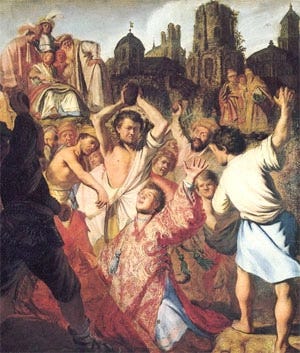Let he who has never broken Sabbath cast the first stone
In Numbers 15, a man was stoned for the Sabbath. The New Testament offers a more human-centered vision, addressing the Sabbath and stonings both.
Well, they'll stone you when you're trying to be so good
They'll stone you just like they said they would
They'll stone you when you're trying to go home
And they'll stone you when you're there all alone
But I would not feel so all alone
Everybody must get stoned— Bob Dylan, Rainy Day Woman #12 and 35
Taking religion this far doesn’t make you fervent. It makes you a fundamentalist.
Numbers 15 tells the story of an Israelite who got stoned for the Sabbath.
The man is caught gathering wood, on the day set apart for rest. He has broken the Fourth Commandment, to “remember the Sabbath day by keeping it holy” (Exodus 20:8-11).
The Old Testament says many harsh things. Even people who chose to believe the Bible literally don’t live it. Especially as relates to the Sabbath. Exodus 35:2 tells that “Whoever does any work on it (Sabbath) must be out to death.”
No matter how literal or how fervent the believer, there are two forms of Sabbath that nobody honors.
Who among us 8 billion humans honors the Sabbath as outlined in Exodus 23, sowing fields and harvesting crops for six years, and giving the field a sabbath year on the seventh?
Didn’t think so. Who among us think we have a year to waste? Or ever has? Fields have a way of going fallow.
Exodus 35:2 offers no exceptions, but the Old Testament says many such things, as in Exodus 21. In verses 15 and 17, it tells us that people who attack their parents physically, or curse them, are to be killed. The existence of teenagers is proof of how little-honored that rule is.
It’s in the Book, sure. But it’s not taken that seriously. It seems a bit harsh.
When Israelites see a man gathering wood on the Sabbath in Numbers 15, they detain him, not knowing what to do.
That they didn’t know what to do, despite the edict that Sabbath-breakers are to die, indicates the Israelites understood the verses the way we do: A bit harsh. What’s the real answer?
To which God responded: The law is the law.
In Numbers 15:34 God tells Moses: “The man must die. The whole assembly must stone him outside the camp.”
Man was unsure; God was not.
Stoning is a primitive form of death. Unlike firing squads or lethal injections or the electric chair of modern times, a quick death is no promise in a stoning.
And unlike capital punishment as we know it, stoning is not outsourced to law enforcement, or done out of public view.
Stonings happen in the town square. With every stone thrown, a community’s ethic is reinforced.
You’ve heard of people who “throw a stone and hide their hand?” This involves the toss of a single stone, normally.
Stonings are the opposite. Being seen with stone in hand, and tossing it, is doing your part.
When God ordered a 9/11 style purge of the Israelites in Exodus 32, after the golden calf incident, the Levites stepped up. They killed 3,000 people.
But the stoning in Numbers 15 was not left to the enforcement unit. It was carried out by “the whole assembly.”
In the New Testament, Jesus addresses both matters, the stoning and the Sabbath.
In Mark 2, Jesus technically risks his life. One Sabbath, he and his disciples walked in a grain field, and picked “heads of grain” from it.
The Pharisees ask: “Why are they doing what is unlawful on the Sabbath?”
Jesus cited Scripture.
“Have you never read what David did when he and his companions were hungry and in need? In the days of Abiathar the high priest, he entered the house of God and are the consecrated bread, which is lawful only for priests to eat. And he also gave some to his companions.”
Then Jesus said the line people remember: “The Sabbath is made for man, not man for the Sabbath. So the Son of Man is Lord even of the Sabbath” (Mark 2:27-28).
John 8 tells the story of a woman caught in the act of adultery, by “teachers of the law and Pharisees.”
A Numbers 15-style tribunal occurs, except this one ends differently. The woman was made to “stand before the group” after the indiscretion.
“In the Law Moses commanded us to stone such women,” the Pharisees said. “Now what do you say?”
The narrator tells us the Pharisees hoped to stump Jesus, “in order to have a basis for accusing him.”
Jesus barely looks up as he offers his answer.
“If any one of you is without sin, let him be the first to throw a stone at her,” Jesus said in John 8:8.
The crowd thins out, “the older ones first,” until no one was left but Jesus in the woman.
Jesus didn’t say “don’t do it, that’s wrong.” Instead he held up a mirror to the Pharisees. It was so easy to dehumanize the woman, to judge her as if she’s the only sinner. To stone her, as if she were the only rule-breaker.
Jesus challenged the Pharisees to look within. He trusted they’d have enough integrity to know that they are sinners. None in the group self-identifies as blameless, so nobody throws a stone. The object lesson has worked better than a speech would have. Jesus helped them see it for themselves.
Rather than The Law with a stone in hand, Jesus offered faith with a human face. Redemption, not condemnation.
Jesus does not excuse the woman. He challenges her to be better.
When Jesus sees that the woman is safe, he asks: “Has no one condemned you?”
“No one, sir,” she said.
“Then neither do I condemn you,” Jesus said. “Go now and leave your life of sin.”






